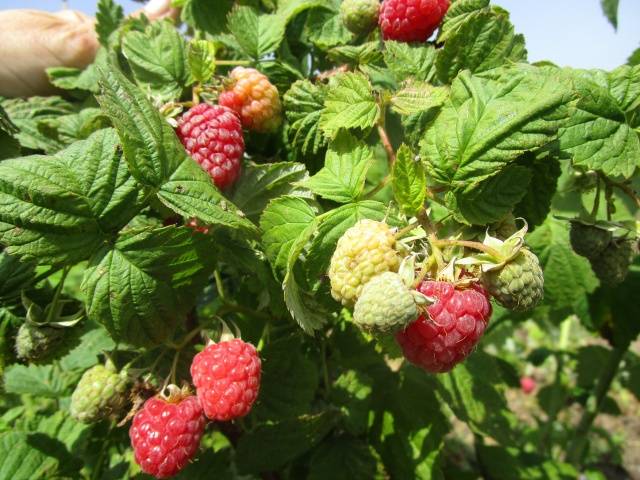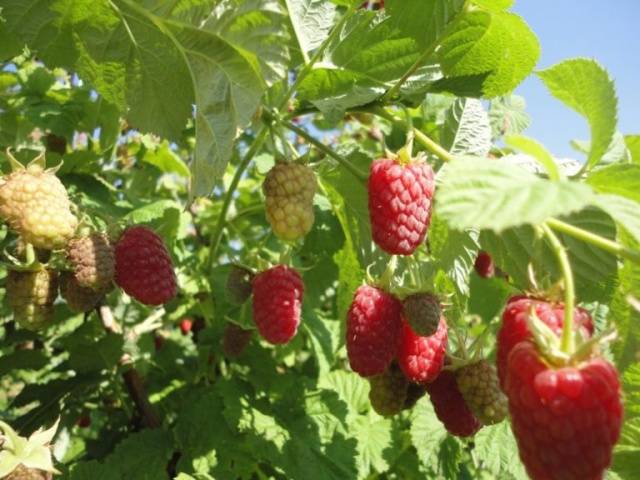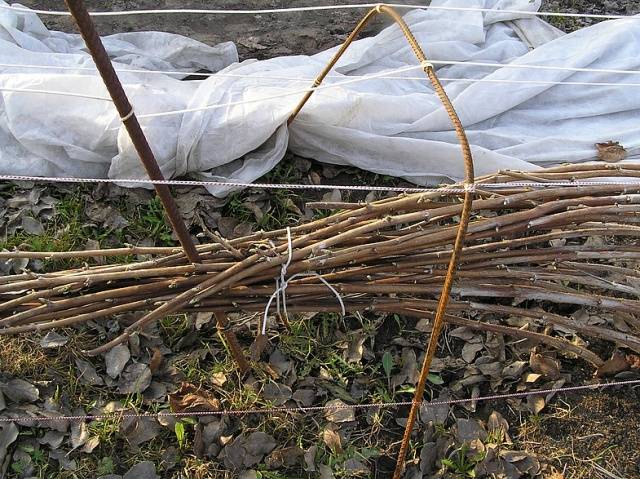Content
Malina Phenomenon was bred by the Ukrainian breeder N.K. Potter in 1991. The variety was the result of crossing raspberries Stolichnaya and Odarka. Raspberry The phenomenon is prized for its large size and sweet taste.
Variety characteristics
According to the photo and description, the raspberry variety The phenomenon has a number of features:
- mid-early ripening;
- semi-spreading bush;
- the height of the shoots is 2.5-3 m;
- small thorns located along the entire length of the branches;
- dark green leaves with pubescence;
- by autumn, the shoots change color from light green to yellow.
Characteristics of Phenomenon berries:
- in the first year, the fruits are round in shape;
- in adult bushes, the berries are cone-shaped;
- weight from 5 to 9 g;
- rich crimson color;
- simultaneous ripening of fruits;
- dense juicy pulp;
- sweet taste with a slight sourness.
The yield of the Phenomenon variety is up to 8 kg of berries per bush. Fruiting begins in mid or late July. After picking, the berries are stored for no more than 5 days. Raspberries are eaten fresh, frozen and processed.
Raspberry Phenomenon is grown commercially. The variety is considered reliable and unpretentious, suitable for mechanized harvesting.
Planting raspberries
The Phenomenon variety is planted on sites after careful preparation. The landing site is chosen taking into account the predecessors. Mineral and organic fertilizers are applied to the soil. Saplings are chosen with strong roots and 1-2 shoots.
Site preparation
An area constantly illuminated by the sun is chosen under the raspberry tree. The yield, size and taste of Phenomenon berries depend on the availability of access to the sun's rays. In the shade, the shoots stretch out, and the raspberries lose their taste.
Raspberry The phenomenon grows on loamy and chernozem soils. Low-lying areas in which water accumulates are not suitable for planting a culture. On the rise, raspberries suffer from a lack of moisture. The best options are flat areas or with a slight slope.
The best precursors for the Raspberry Phenomenon are green manures, legumes, cucumbers, onions, and garlic. After tomatoes, peppers and potatoes, raspberries are not planted, since the crops have common diseases.
Planting work is carried out in the fall in the last days of September or until the end of October. The beds are dug up and cleaned of weeds... 1 m2 6 kg of rotted manure, 50 g of superphosphate and 30 g of potassium sulfate are introduced into the soil. A month before the planting of the raspberry Phenomenon variety, loosen with a rake.
When planting raspberries in the spring, the soil is dug up and fertilized in the fall. Then, after the snow melts, it is enough to carry out deep loosening. Work takes place from late April to mid-May.
Work order
Saplings of the Phenomenon variety are purchased in nurseries. When buying planting material from an unverified supplier, there is a high risk of getting low-quality seedlings.
Raspberries are judged externally by the condition of the shoots and the root system. The number of branches should be 1-3. Healthy roots do not have dry or rotten areas.
Raspberry planting procedure:
- First, you need to dig a hole with a diameter of 40 cm and a depth of 50 cm.When planting several plants, leave 50 cm between them.
- 10 kg of humus, 500 g of wood ash, 70 g of superphosphate and potassium salt are added to the upper soil layer.
- The roots of the seedling are dipped in a solution of mullein and growth stimulant.
- Raspberry Phenomenon is cut to a height of 30 cm.
- The plant is placed in a hole and covered with earth.
- The soil is compacted and watered abundantly.
After planting, the Phenomenon raspberries are watered every week. The soil is mulched with humus or straw. Instead of a hole, you can dig trenches 40 cm wide and 50 cm deep. Plants are placed in 50 cm increments, after which their roots are covered with earth.
Variety care
According to the description of the variety, photos and reviews, the raspberry phenomenon gives a bountiful harvest with constant care. The variety responds positively to regular watering, top dressing and pruning. Bushes are tied to a trellis.
Watering
With frequent precipitation, raspberries will receive the required amount of moisture. In a drought, the bushes are watered so that moisture penetrates to a depth of 40 cm.
The need for the Phenomenon variety for watering is especially high during flowering and moisture ripening. In May, 3 liters of water are added under each bush. In June and July, raspberries are watered twice, 6 liters of water is enough for one bush. In August, one watering is carried out until the middle of the month.
In the fall, winter watering is performed, allowing the plants to survive the winter. After adding moisture, the soil is loosened so that the plants better absorb nutrients from the soil. Mulching the soil helps to reduce the number of watering.
Fertilization
If, during planting, mineral and organic fertilizers were introduced into the soil, then feeding begins in 2-3 years.
The procedure for feeding raspberries Phenomenon:
- in the spring, a solution is prepared consisting of 1 liter of slurry and 10 liters of water;
- during the formation of fruits, a solution of 20 g of superphosphate and potassium salt is added to a large bucket of water;
- in August, a solution is obtained that includes 10 liters of water and 2 tbsp. l. potassium sulfate;
- in the fall, the soil is dug up, fertilized with wood ash and humus.
Mineral solutions are added under the raspberry root. Nitrogen fertilizers are used only in early spring before flowering, so as not to provoke the growth of green mass.
Pruning
In the spring, the frozen shoots are cut off from the Phenomenon variety. 8-10 shoots are left on the bushes, which are shortened by 15 cm. The remaining branches of the raspberry are cut out at the root.
In the fall, two-year-old shoots from which the harvest is harvested are eliminated. Young and weak branches of raspberries, unable to withstand the winter, are also cut out.
It is recommended to burn all trimmed raspberry shoots in order to get rid of possible pests and pathogens.
Tying
According to the photo and description, the raspberry variety The phenomenon is tall. By tying them to a trellis, raspberry bushes receive the necessary lighting. The presence of a support simplifies harvesting and cultivating the variety.
To install the trellises, you will need metal pillars 2 m high. They are placed every 5 m. Then the wire is pulled at a level of 0.8 m and 1.5 m from the ground.
Raspberry shoots are placed on a trellis and tied up. If necessary, pull an additional wire at a level of 1.2 m.
Protection against diseases and pests
Failure to comply with agricultural techniques or the use of low-quality seedlings on raspberries, there are signs of disease. According to the description of the variety and reviews, the raspberry Phenomenon remains resistant to diseases.
Viral diseases are especially dangerous, leading to thinning of shoots and slow development of raspberries. The affected bushes are eliminated, and the raspberry planting site must be changed.
Fungal diseases are spread by high humidity and low temperatures. They are determined by the presence of spots on the stems and leaves, I rot raspberries. Bordeaux liquid and other preparations containing copper are effective against the fungus.
Plants attract aphids, gall midges, weevils, and raspberry beetles. Pests are fought with insecticides Karbofos, Metaphos, Actellik. Folk remedies help protect the planting of raspberries: tobacco dust, watering with infusions on onion peels.
Shelter for the winter
Raspberry Phenomenon does not need special shelter for the winter.Under the snow cover, the bushes tolerate cold snaps well.
Shoots are removed from the support and laid on the ground after leaf fall. In the absence of snow, the raspberry tree is covered with agrofibre, spandbond or lutrasil, which allows air to pass through. In the spring, the shelter from the raspberries is removed to avoid the bushes damping out.
Gardeners reviews
Conclusion
Raspberry Phenomenon is resistant to drought and frost. The variety brings a high yield of delicious berries. The main care of the raspberry tree includes watering, mulching, feeding and pruning the bushes.












